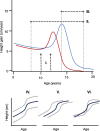Trans-ancestral genome-wide association study of longitudinal pubertal height growth and shared heritability with adult health outcomes
- PMID: 38229171
- PMCID: PMC10790528
- DOI: 10.1186/s13059-023-03136-z
Trans-ancestral genome-wide association study of longitudinal pubertal height growth and shared heritability with adult health outcomes
Erratum in
-
Author Correction: Trans-ancestral genome-wide association study of longitudinal pubertal height growth and shared heritability with adult health outcomes.Genome Biol. 2024 May 21;25(1):129. doi: 10.1186/s13059-024-03276-w. Genome Biol. 2024. PMID: 38773652 Free PMC article. No abstract available.
Abstract
Background: Pubertal growth patterns correlate with future health outcomes. However, the genetic mechanisms mediating growth trajectories remain largely unknown. Here, we modeled longitudinal height growth with Super-Imposition by Translation And Rotation (SITAR) growth curve analysis on ~ 56,000 trans-ancestry samples with repeated height measurements from age 5 years to adulthood. We performed genetic analysis on six phenotypes representing the magnitude, timing, and intensity of the pubertal growth spurt. To investigate the lifelong impact of genetic variants associated with pubertal growth trajectories, we performed genetic correlation analyses and phenome-wide association studies in the Penn Medicine BioBank and the UK Biobank.
Results: Large-scale growth modeling enables an unprecedented view of adolescent growth across contemporary and 20th-century pediatric cohorts. We identify 26 genome-wide significant loci and leverage trans-ancestry data to perform fine-mapping. Our data reveals genetic relationships between pediatric height growth and health across the life course, with different growth trajectories correlated with different outcomes. For instance, a faster tempo of pubertal growth correlates with higher bone mineral density, HOMA-IR, fasting insulin, type 2 diabetes, and lung cancer, whereas being taller at early puberty, taller across puberty, and having quicker pubertal growth were associated with higher risk for atrial fibrillation.
Conclusion: We report novel genetic associations with the tempo of pubertal growth and find that genetic determinants of growth are correlated with reproductive, glycemic, respiratory, and cardiac traits in adulthood. These results aid in identifying specific growth trajectories impacting lifelong health and show that there may not be a single "optimal" pubertal growth pattern.
© 2023. The Author(s).
Conflict of interest statement
Diana L. Cousminer is an employee of and shareholder of GlaxoSmithKline (GSK). Mark McCarthy is employed by Genentech and a holder of Roche stock. John Perry is an employee and shareholder of Adrestia Therapeutics. Christine Frithioff-Bøjsøe is currently employed at Novo Nordisk. This work is unrelated to any activities at these companies.
Figures




References
-
- Palmert MR, Boepple PA. Variation in the timing of puberty: clinical spectrum and genetic investigation. J Clin Endocrinol Metab. 2001;86:2364–2368. - PubMed
-
- Silventoinen K, et al. Genetic regulation of growth from birth to 18 years of age: The Swedish young male twins study. Am J Hum Biol. 2008;20:292–298. - PubMed
Publication types
MeSH terms
Grants and funding
- UM1 DK126194/DK/NIDDK NIH HHS/United States
- U54 AG062334/AG/NIA NIH HHS/United States
- KL2 TR002381/TR/NCATS NIH HHS/United States
- T32 HL129982/HL/NHLBI NIH HHS/United States
- MC_PC_15018/MRC_/Medical Research Council/United Kingdom
- T32HL129982/NH/NIH HHS/United States
- UL1 TR002378/TR/NCATS NIH HHS/United States
- WT_/Wellcome Trust/United Kingdom
- R01 HD056465/NH/NIH HHS/United States
- G9815508/MRC_/Medical Research Council/United Kingdom
- MC_UU_12015/2/MRC_/Medical Research Council/United Kingdom
- MC_UU_00006/2/MRC_/Medical Research Council/United Kingdom
- MC_UU_12015/2/MRF/MRF/United Kingdom
- 212259/Z/18/Z/WT_/Wellcome Trust/United Kingdom
- MC_PC_19009/MRC_/Medical Research Council/United Kingdom
- R56 DK101478/DK/NIDDK NIH HHS/United States
- WT220390/WT_/Wellcome Trust/United Kingdom
- MC_UU_00006/2/MRF/MRF/United Kingdom
- R01 HD101669/HD/NICHD NIH HHS/United States
- MC_UU_12019/2/MRC_/Medical Research Council/United Kingdom
- 20/0006307/DUK_/Diabetes UK/United Kingdom
- R01 HD056465/HD/NICHD NIH HHS/United States
- G0802782/MRC_/Medical Research Council/United Kingdom
LinkOut - more resources
Full Text Sources
Medical

